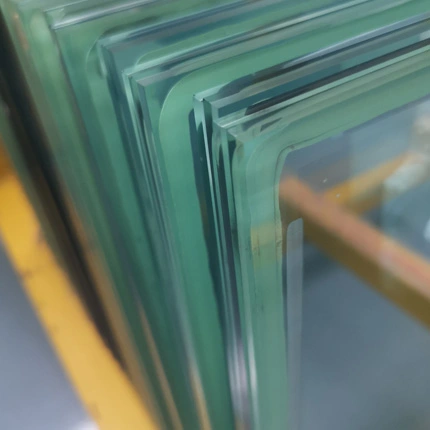
Vacuum laminating glass is created by bonding two or more pieces of glass together with a thin vacuum space in between.
This vacuum is created during the manufacturing process in vacuum glass factory and removes air molecules from the space.
A resin or adhesive then bonds the double vacuum glass layers together, creating a strong and durable composite.
Thickness | 3/3, 4/4, 5/5. 6/6, 8/8 + PVB/EVA/SGP + Temp Glass ; |
Maximum size | 1500 x 3600 mm |
Special shapes | Oval, arch, triangle, half arch and more |
U-Value | 0.27 W/(m².K) |
Acoustic performance | 42-45=48(-2;-4) Rw (C; Ctr)(dB) |
LT – Light transmission | 44-75% or above |
Low emissivity coating | Yes, in accordance with EN 1096 / EN 12150-1 |
Principles of Vacuum Laminated Glass
VLG consists of two primary components: a vacuum layer and a laminated glass structure. The vacuum layer effectively eliminates air between two panes of glass, significantly reducing heat transfer by conduction and convection. This vacuum insulation principle is similar to what is used in vacuum insulated panels (VIPs) and thermos flasks, which are known for their exceptional thermal insulation properties.
The laminated aspect of VLG involves bonding two or more layers of double pane windows vacuum glass with interlayers of polyvinyl butyral (PVB) or ethylene-vinyl acetate (EVA), similar to traditional laminated glass. This lamination process not only adds strength and durability to the glass but also ensures that if the glass is broken, the shards remain adhered to the interlayer, reducing the risk of injury.
Manufacturing Process
Glass Preparation: The process begins with cutting and cleaning the glass panes to the desired size. The surfaces must be free of impurities to ensure a strong bond in the lamination process and to maintain the integrity of the vacuum seal.
Assembly of Glass Panes: Spacers are placed around the edges of one glass pane, leaving a small opening for the vacuum to be created. The second pane is then aligned and placed on top.
Evacuation: The assembly is placed in a vacuum chamber, where air is evacuated from the space between the glass panes through the small opening left by the spacers. This step creates the vacuum insulation layer.
Sealing: Once the desired vacuum level is achieved, the opening is sealed hermetically, locking the vacuum in place. This step is critical to ensure the long-term performance of the VLG.
Lamination: The vacuum-sealed glass panes are then laminated with interlayers of PVB, EVA, or other suitable materials. The assembly is placed in an autoclave, where it is subjected to heat and pressure. This process ensures the interlayers bond securely to the glass panes, completing the VLG unit.
Quality Control: The final step involves inspecting the VLG units for any defects, ensuring the vacuum seal’s integrity, and verifying the lamination quality. Units that pass these inspections are then cleared for use.
Low U-Value: Vacuum laminated glass typically achieves low U-values, indicating its ability to resist heat flow. This results in reduced heat loss during the winter and reduced heat gain during the summer, contributing to overall energy efficiency.
Safety and Security: Like traditional laminated glass, vacuum laminated glass provides safety and security benefits. In the event of breakage, the glass layers remain bonded to an interlayer, preventing shards from scattering and reducing the risk of injury.
UV Protection: Vacuum laminated glass can be manufactured with interlayers that offer UV protection, helping to block harmful ultraviolet rays that can cause fading and damage to interior furnishings, artwork, and flooring.
Aesthetic Versatility: Vacuum laminated glass can be used in a variety of architectural applications where both performance and aesthetics are important. It can be incorporated into facades, windows, doors, partitions, and other building elements while maintaining a sleek and modern appearance.
Energy Efficiency: By reducing heat transfer and improving thermal insulation, vacuum laminated glass contributes to overall energy efficiency in buildings. It helps reduce heating and cooling loads, leading to lower energy consumption and operating costs.
Pls contact us if you have any inquire or questions, thank you.
No.12111, JINGSHI ROAD, LIXIA DIST, JINAN CITY, SHANDONG PROVINCE, CHINA